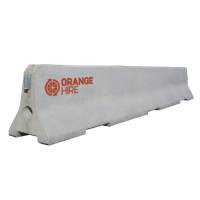What do the MASH Test specifications mean for concrete safety barriers?
Road safety barriers can be used on any site where there is potential for workers or roadwork plants to be struck by passing traffic. They are an important passive safety tool that keeps worksites and vehicles separated, by preventing traffic from impacting hazardous objects or deep excavations within a work site.
Although road safety barrier systems just look like big chunks of concrete, each road barricade is a highly engineered product that is specifically designed to deflect or redirect errant vehicles in a very predictable way.
The impact performance of concrete safety barriers is influenced by a number of different variables, including the profile of the barrier, its height, and the length of the entire row of installed barriers. The strength and amount of give in the joints, along with friction between the barrier and the road surface also contribute to how it performs on site.
Designed for safety
Here are some of the safety specifications you can find on a typical MASH tested road barrier and what they mean:
1. Test Level
This is the most important specification for a concrete road barrier, as it will determine the roads it can be used on.
For example, the Deltabloc road barriers supplied by Orange Hire have a test level of TL-3, which indicates they can be used on roads with posted speed limits up to 100km/hr in NSW and VIC, and 80km/hr in QLD.
2. Deflection
Most traffic barriers prevent vehicles from causing too much damage by deflecting cars back in line with the direction of traffic, rather than straight into the work zone.
Deflection is a measurement of how far the barrier shifts sideways into the work zone when it is hit by a car.
For the Deltabloc barrier, this measurement is 257mm (when impacted by a car travelling at 100km/hr, impacting at a 15° angle).
3. Working width
The working width is the distance between the face of the barrier that points towards the road before an impact, and the maximum lateral position of any major part of the system or vehicle during and after the impact. To put it simply: the outside edges of the carnage after an impact.
Taking note of the working width ensures you and your team have a safe zone when working alongside traffic. Our concrete safety barriers have a working width category of W6.
To complicate things, barriers can be tested over a range of different speeds and impact angles, so the W6 categorisation refers to a range of test results with certain parameters.
4. Tested system length
MASH Testing must include full-scale crash testing, so the test result will indicate the actual length of the line of barriers that were tested.
A long run of barriers will perform differently than just a few coupled together, so it’s important to take note of the recommended installation length.
5. Profile
The profile of a concrete barrier is designed so that it will effectively sweep a car along the road, rather than launching it into the air. To be effective, a barrier must possess sufficient structural integrity to contain and redirect vehicles, and it can be complemented by crash cushions and other safety hardware to enhance overall road safety. This is why they typically have similar shaped wide bottoms and narrow top edges, regardless of the brand.
The terms jersey barrier, F Type barrier and concrete crash barrier are often used interchangeably in the industry, but the profiles can be slightly different.
Stay safe with concrete road safety barriers from Orange Hire 
Along with other measures like temporary slower speed limits, variable message signs and temporary traffic lights, you can ensure that you’re creating the safest environment for your team.
Give the Orange Hire team a call for detailed information on how to ensure you are adequately protected when working alongside traffic.















